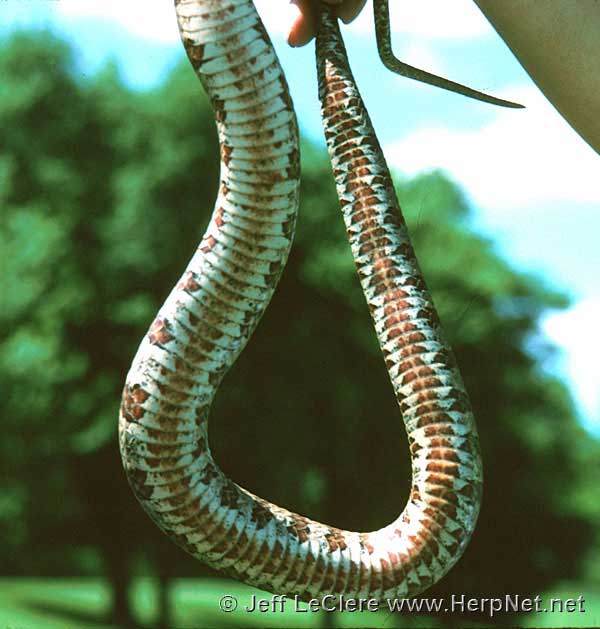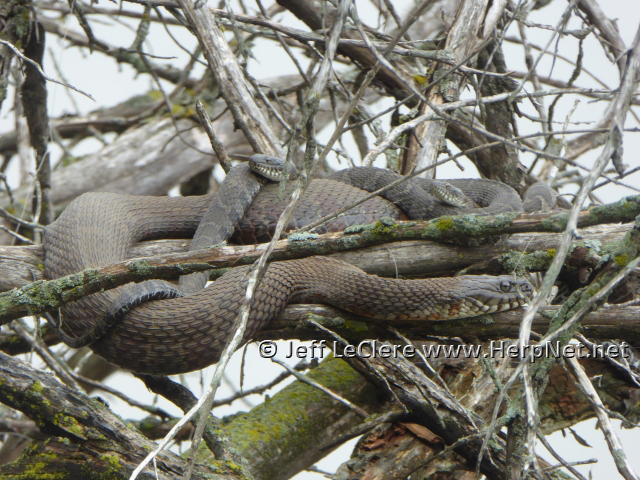Common Water Snake (Nerodia sipedon)
Alternate names: Common Watersnake; Northern Watersnake
by Jeff LeClere
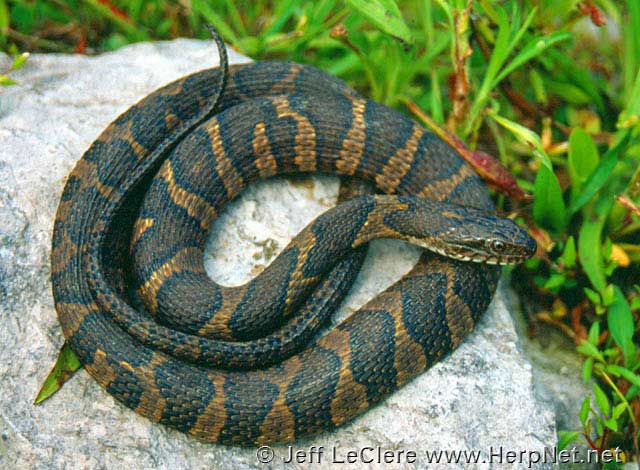
Status
PROTECTED and Species of Greatest Conservation Need. It is illegal to kill or collect this species by law in Iowa. This is one of Iowa’s most commonly seen snakes. They can be found in nearly every waterway and are usually seen while fishing.
Description
Harmless to humans. Common water snakes are medium to large sized Iowa snakes. They range in length from 24 – 42 inches (Conant and Collins, 1998) and may be quite heavy bodied as adults. There are so many pattern and color variations in certain populations, and in individual common water snakes, that to list them all is not feasible for the length of this account!
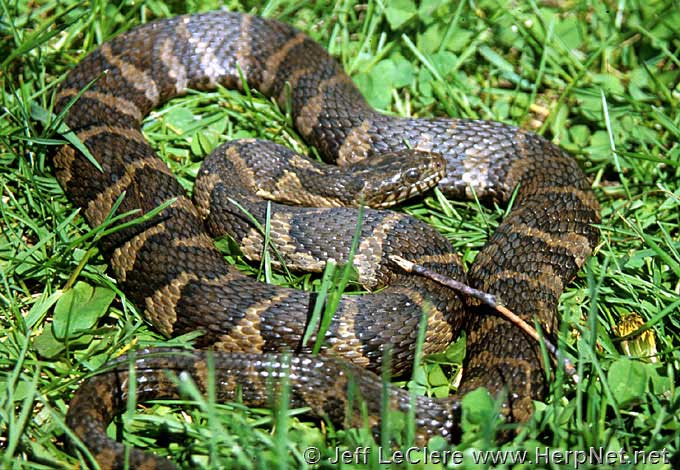
Generally, they have light brown or reddish markings on a brown or grayish ground color. The markings consist of bands on the neck that become blotches on the back. There are smaller alternating spots on the sides and the ones closest to the ventral scales have a tendency to be red or reddish. The tail is ringed and the rings are the same color as the dorsal markings. The belly is white with brown or red half-moon shaped markings. These markings are sparse or absent anteriorly and become much more numerous posteriorly. Sometimes there is a yellow, orange, or pink stripe running longitudinally down the center of the vent. The crescent shaped markings may still be present with this stripe, but if they are not, there may be very small gray or brown dots scattered randomly about the belly.
Larger adults may be a solid brown or black when they are dry. Newborn common water snakes have a gray or very light brown ground color with striking black or dark brown bands and blotches. The crescents on the belly usually have no red but are solid black or brown instead. Subadults are quite reddish in overall appearance.
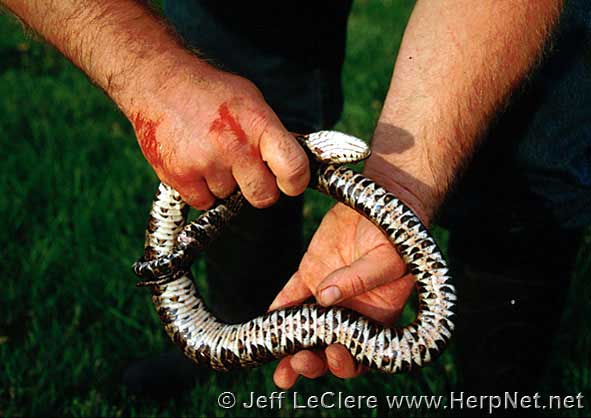
Subspecies
The northern water snake, Nerodia sipedon sipedon, is the subspecies found in Iowa.
Range
The northern water snake is found statewide in Iowa except in the northwest.


Habitat
The very common northern water snake is, as its name implies, a snake of the water. Ponds, marshes, streams, river backwaters, and lakes provide the preferred habitat for this serpent. Thick vegetation along the banks with small shrubs and trees afford basking opportunities that are important for this species. It adapts rather well to moderate human interference. City parks with water and even heavy traffic fishing spots may have good populations of northern water snakes.
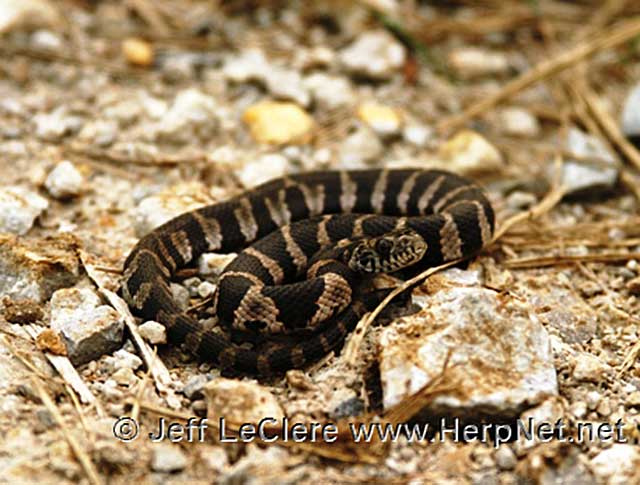
Habits
Northern water snakes are by far the most abundant of the three water snake species in Iowa, and also one of the most common large snakes in general. It is often seen by anglers, who may mistake them for the venomous cottonmouth, which is not found in Iowa. This snake is diurnal, even during hot weather. It may be observed basking upon branches, shrubs, tree roots, and along the banks of waterways, often in large numbers on a favorite basking spot. Young and newborn water snakes may be found hiding beneath logs or flat rocks close to water. They are wary and will slip off their basking perch at any sign of danger. Some may swim with their heads above water to the other side of the bank or swim back to the shore in a semi-circle. Others will dive to the bottom and anchor themselves to logs, branches, rocks, or other debris. Most will resurface within five minutes, but they are capable of remaining submerged for an hour and a half (Ferguson and Thornton, 1984)!
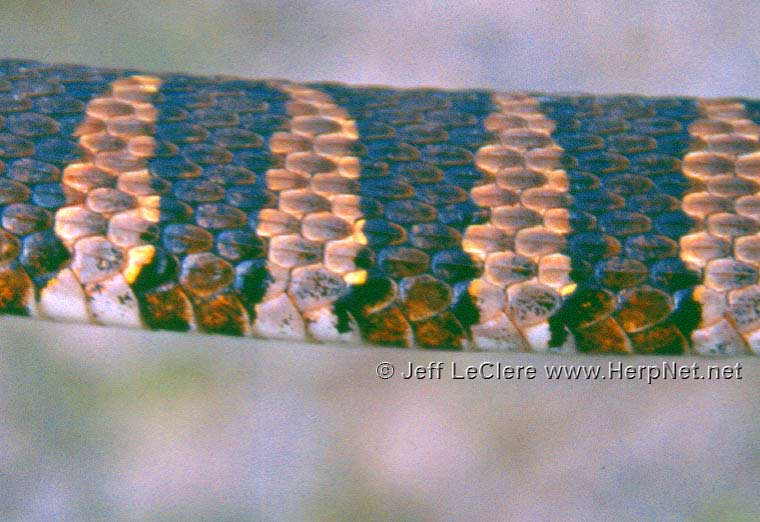
If cornered, they will flatten their jaws and bodies making themselves look like ribbons! They will strike and bite viciously and repeatedly. If picked up, they will release musk and fecal matter, and in very nervous specimens, regurgitating any recently eaten meal. Even after being held for some time, they will not miss an opportunity to bite, and their saliva reportedly contains anticoagulant properties that make the lacerations bleed profusely. The treatment, however, is only soap and water. These are harmless snakes! The famous, and venomous, cottonmouth (or water moccasin), Agkistrodon piscivorus, is not found in Iowa. The farthest north cottonmouths have been recorded is central Missouri.
Northern water snakes are active from April to October, spending their winters in rock crevices they have migrated to from the water. I found a neonate northern water snake in Clayton County on September 29. It was found under a rock at the base of a rocky bluff about 60 meters upland from a trout stream. There are often other species of snakes overwintering with them. Neonates of this species will often overwinter communally and in relatively large numbers when compared to the adults. Some may overwinter near their summer sites if suitable dens such as burrows, large rocks, bridges, or dams exist. They emerge in spring and migrate back to their summer sites close to water. This is where copulation takes place. I have seen two pairs of northern water snakes copulating in Louisa County on May 2. Many males may court one female at the same time. The females are usually quite a bit larger than the males. The pair usually will select a basking perch such as a shrub or branch overhanging water for copulation. Matings have been observed on the banks or even in the water, however.
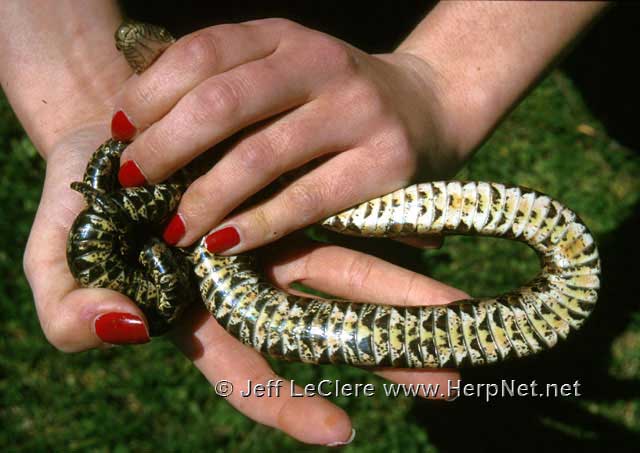
During breeding, both snakes may make undulating movements with their bodies and the pair may remain “locked up” for an hour or more. Young are born alive in late June into August. They are roughly 6 – 10 inches at birth and are pugnacious like the adults. Five to sixty young may be produced in a single litter or a couple litters a few days apart and there is a fantastic account of 99 young born in a litter to one female! A large female from Linn County gave birth to fifteen young in July.
Food
Northern water snakes are active hunters and may hunt both day and night. They feed on a wide variety of animals associated with water. Fish, amphibians, baby turtles, young snakes, worms, leeches, crayfish, and mammals are consumed. A wider variety of prey is utilized at higher temperatures. They eat small meals every day or every other day and hunt by patrolling the water next to the shore for food. They sometimes swim through a school of small fish with their mouths wide open and swallow anything they can catch or herd fish into a shallow area of water and then create a barrier with a loose coil of their bodies. On a summer night in Louisa County, I was attempting to rescue small turtles and frogs from a dam that had been partially closed. The current was very strong and created a whirlpool near the door of the dam. These animals were trapped on debris that was constantly shifting, but they could not swim out. It was just after dark and a large northern water snake suddenly appeared in my flashlight beam. The snake swam right in and immediately began feeding on the frogs that were trapped. It ate a few, and then suddenly, and quite effortlessly, swam out and disappeared. These snakes are not constrictors and simply swallow prey alive.
